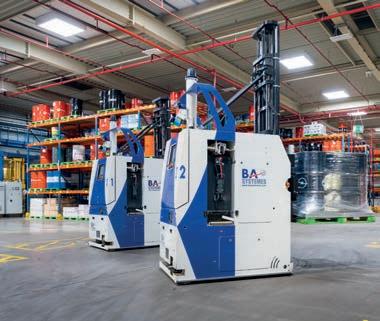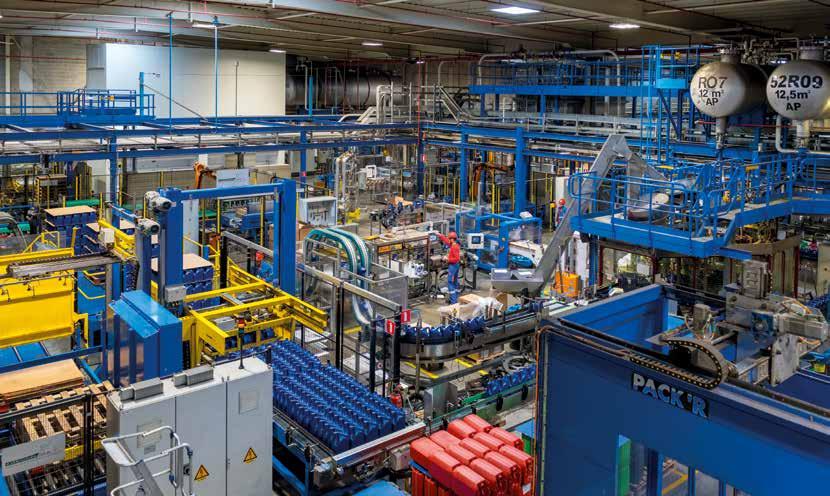
7 minute read
TotalEnergies Blending and
Blending and analysing for Europe and beyond
TotalEnergies
Advertisement
The factory in Rieme, with its high-rise warehouse in the forefront, is just a few hundred metres away from the sea canal from Ghent to Terneuzen, to which it is linked by its own jetty and depot.
If TotalEnergies is a leading global manufacturer of lubricants and the market leader in Belgium, it owes this to no small extent to its blending factory in North Sea Port. On top of being a prime production site, the plant in Ertvelde is also a major logistics hub and a main centre for technical diagnosis and analysis. “In more than one way, this is an exceptional site”, says Plant Manager Filip Van de Vyver.
The year 1991 was a decisive turning point in the history of the plant in Ertvelde, that will celebrate its frst century of existence next year. In 1986 Fina, which later became part of Total, had made the decision to build a brand new lubricants blending unit there. The new factory started up fve years later. “With a degree of automation that was hard to fnd in the lubricants industry at that time and the ability to produce small batches and very complex products, it was a top-notch and innovative installation. And it has remained so, as shown by the fact that in 2020 we received the ‘Factory of the Future’ award, which sets very demanding standards in domains like sustainability, digitisation, energy effciency and autonomy of the people working here”, says Mr Van de Vyver, who recently took over as Plant Manager at TotalEnergies Ertvelde.
Adding wind and sun
The site covers a total surface of 27ha. The actual plant represents 11ha, the tank farm with a storage capacity of 42,800m² along the sea canal (the quay is shared with Oleon and Fuji Oil) another 5ha. Between them lies the area where
Flying a new fag
Total changed its name into TotalEnergies last year. The rebranding is meant to refect the strategic transformation of the group, with its historical focus on oil & gas, into a multi-energy company and its ambition to be a world-class player in energy transition. “We want to become carbonneutral by 2050 and almost halve our CO2-equivalent emissions by 2030, even if that does not mean we will be producing and selling less energy. We will do so by reducing our reliance on petrol fuels, strongly expanding our capacity in renewable fuels and using technologies such as carbon capture and storage to deal with the remaining emissions, since the petrochemical industry will still need oil as a feedstock for plastics”, explains Pascal De Crem, Director Communication at TotalEnergies Belgium. TotalEnergies also adopted a new visual identity with a new logo, the changing colours symbolising the shift from oil (red) and natural gas (blue) to new energies like hydrogen, biomass, wind, and solar (from green to yellow).

TotalEnergies is a global group with a very strong presence and industrial footprint in Belgium throughout the whole energy value chain, e-mobility, recycling, and renewables. Together all these activities account for 5,200 FTE’s at seven major sites. On Belgian roads and highways, 550 fuel stations and 45 truck fuel stations now bear the group’s new logo. TotalEnergies is number one in Belgium for oil product refnery and distribution, and a major player in petrochemicals, gas, and renewable electricity. The international headquarters of the group for refnery and chemistry are based in Brussels (600 employees). The refnery in Antwerp is the third largest in Europe and is integrated with production units for polymers and olefns (1,800 people). Feluy, the third largest site with 830 employees, harbours the main factory for polymers of the group in Europe, its largest storage depot for fuels, and the European R&D centre for polymers.
Photo courtesy of Limit Fotografe.
Filip Van de Vyver, Plant Manager at TotalEnergies Ertvelde.
Photo courtesy of Limit Fotografe.

Automated vehicles are used in the storage area.
an old factory once stood, and which will need remediation before any new development can happen. Operational excellence has been constantly improved. The capacity of the factory, which runs on a three shifts/fve days a week production scheme, has sharply gone up since 1991, increasing from 130,000 to 230,000t a year as a consequence of new investments. New steps to further enhance the sustainability of the site are also being taken. Renewable energy will soon make a marked entry: the construction of a windmill and the installation of solar panels on the roofs are being studied. Eco-friendliness is not forgotten. Surfaces have been dehardened, non-indigenous trees weeded out and bee hotels have been set up in the green buffers on the factory ground.
Blending and packaging
What Ertvelde does, is blending base oil with additives – “in hundreds of different formulas” – to produce lubricants destined for the automotive industry (as frst-fll grease in new vehicles and in refll canisters that a driver can buy in a shop), other industries (to keep machines in good working order), shipping (for the greasing of engines in inland and seagoing vessels), biodegradable applications, food and pharmaceuticals (‘white’ and ashless oils). The automotive industry is still the main client, with a share of about 45%, followed by the other industries and the marine sector. But biodegradables and white oils are gaining importance. Last year, a new production line for white oils was added. Another one for ashless products is under construction. “We constantly invest in very high-grade products. It is part of the transition we are going through.” Blending and flling/packaging are the main activities in terms of employment, with about two thirds of the total staff of 220 people.
Logistics hub
For both the incoming and outgoing fows, the location in a port area like North Sea Port and along the sea canal linking Ghent to Terneuzen is vital. A big chunk of the raw materials is brought in by seagoing vessels and barges, some of which are chartered for the longer term, the rest by trucks. Downstream, TotalEnergies Ertvelde mainly serves the European market. A smaller part of the output is exported overseas (mostly via a central warehouse of the group in the French port of Rouen). “Our central location in a port strongly contributed to making us the most important logistical and commercial hub of TotalEnergies for the distribution of lubricants in Western, Eastern and Northern Europe, and one of the four main hubs worldwide within the group for marine lubes, on a par with Athens, Hong Kong, and New Jersey. In this niche, we focus on the ports in Northern Europe, France included, and more specifcally the Amsterdam-Rotterdam-Antwerp (ARA) range, the UK and Hamburg, following up every delivery in these ports.” “Last year our blended volume reached 188,000t. About half of this was distributed in bulk by truck (79,000t) or tanker
Photo courtesy of Limit Fotografie.
TotalEnergies Ertvelde packages part of its lubricants in canisters, drums, and IBC’s.

This plant was a top-notch installation when it started up in 1991. And it has remained so: in 2020 we received the ‘Factory of the Future’ award.
barge (20,000t). The remaining volume was unitised in canisters, drums, and IBC’s ranging from 1,000 to just 1 litre (with drums taking up 44,000t). One of the recent investments in this field was our new filling line for 4 and 5 litre canisters and small packs in 2019.” For the storage of packaged goods, TotalEnergies Ertvelde was equipped with a high-rise automated warehouse with a height of 30m, another example of how innovative the new factory was from the start. “At the time, this was quite unique”, Mr Van de Vyver states.

Diagnostics
The third pillar in the activity of the plant is the LubAnac diagnostics and analysis centre. This ultra-modern central laboratory analyses samples of used lubricants to help professional clients to better manage their fleet. By monitoring the performance of their vehicles, engines or machines, LubAnac allows them to lower their fuel consumption, thereby reducing their emissions, and adapt their maintenance strategy, prolonging the lifespan of their equipment. LubAnac is fully automated, but still employs 30 people. The centre in Ertvelde treats about 260,000 samples a year, but is connected to thirty other laboratories worldwide that bring the total to 430,000 diagnoses fed each year into a database that already contains more than 7.5 million entries. This makes the diagnostical reports all the more accurate. “LubAnac will be able to tell customers whether the wear and tear of their engine or machine is normal or not, and sometimes even which specific part of it needs a revision. It is a service which many clients – even smaller hauliers – appreciate a lot.”
Photo courtesy of Limit Fotografie.










